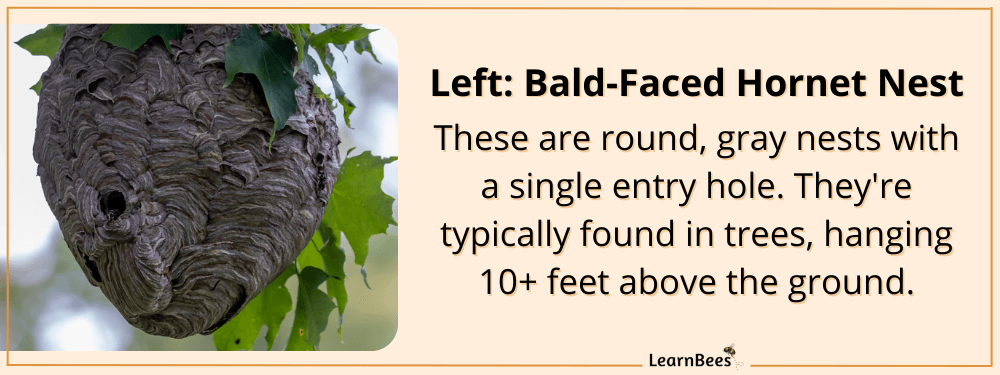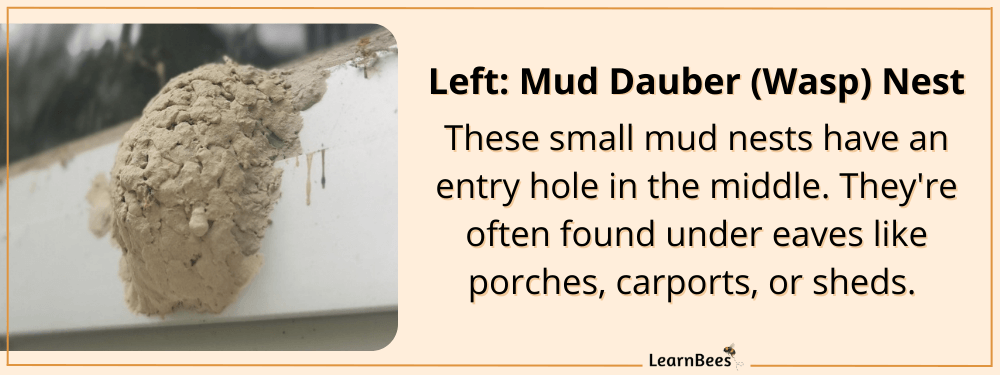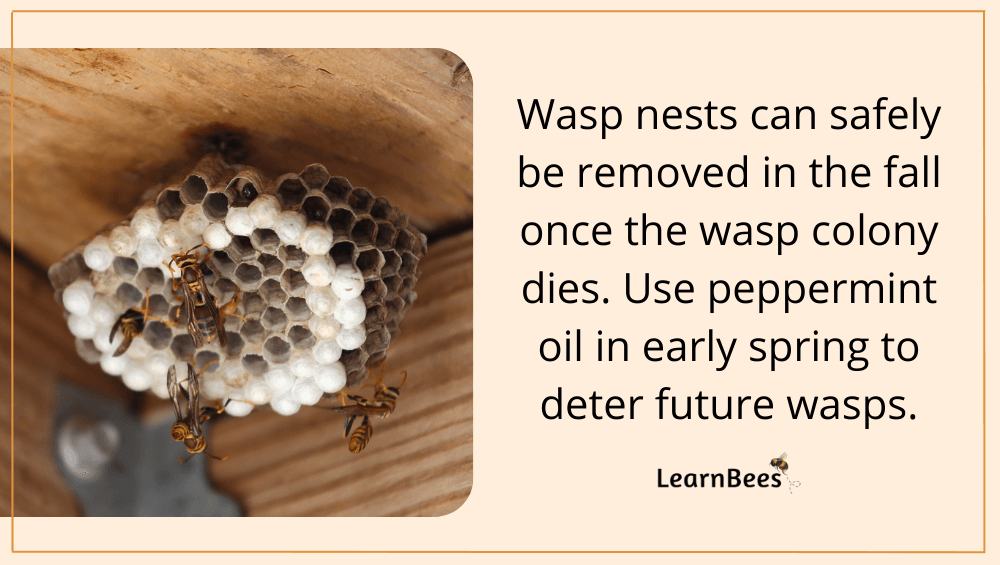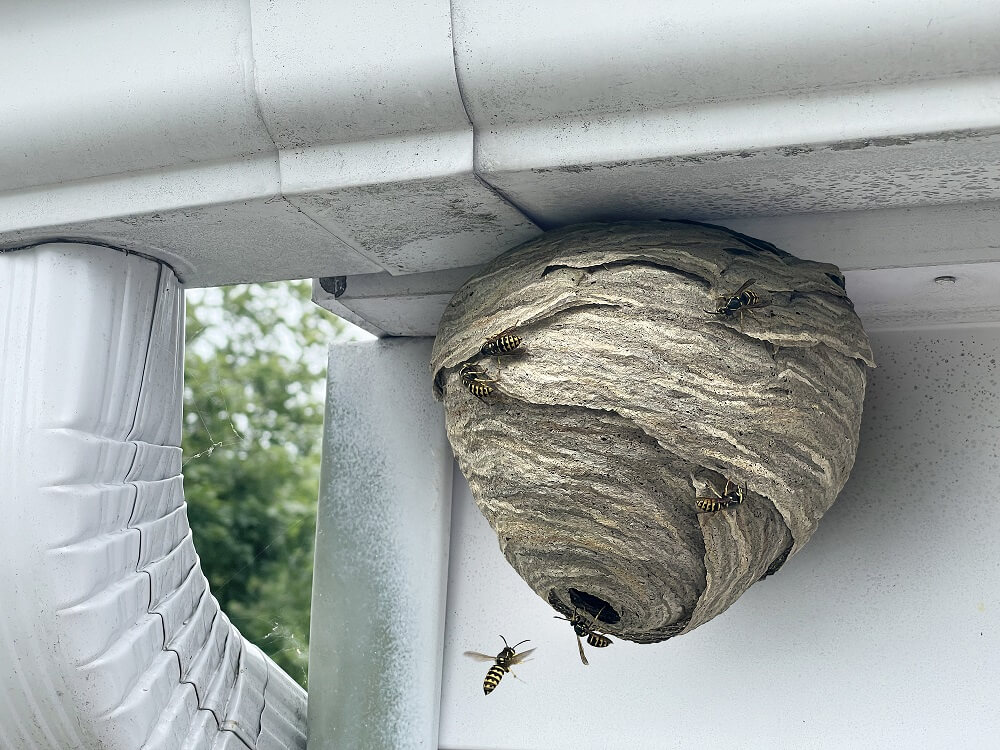Table of Contents:
Wasp Nest vs. Bee Nest:

Wasp nests are the most common nests we see. You’ll usually find them under your porch, carport, shed, or other eaves of your home.
But here’s the thing:
Wasps and bees are beneficial insects.
For example, wasps offer excellent pest control for our food crops by eating bugs like caterpillars and whiteflies. Without wasps, the world could be over-infested with spiders and other insects.
And as for bees?
They’re responsible for nearly 1 in 3 bites of food we eat. Crops like blueberries, cherries, and almonds rely on bees for pollination.(1, 2)
With that in mind, there are natural ways to deter wasps and bees without hurting them. More on that in a bit.
Now let’s cover the most common types of wasp and bee nests:
- Paper wasps
- Bald-faced hornets
- Mud daubers
- Honeybees
Paper Wasp Nest:

Paper wasps’ nests famously look like upside-down umbrellas. They’re gray with many small holes in them.
Paper wasps create their nests with wood fiber collected from plants, which is chewed to form paper-like, hexagonal cells.
Their colonies are small, usually with less than 100 adult wasps.(3)
Before the cold weather arrives, the majority of the paper wasp colony will die. As a result, they abandon their nests, and you can safely remove the nests in the fall.
Bald-Faced Hornet Nest:

Bald-faced hornets usually nest in trees, typically 10+ feet above the ground. Bald-faced hornet nests often grow to be the size of a basketball or larger.
They chew wood fibers to create a gray paper-like material to build their nests. They live in colonies with 100-500 members.
Like other wasps, bald-faced hornet colonies will die in the fall before the cold weather arrives. As such, their nests will be abandoned.(4)
Mud Dauber Nest:

Mud dauber nests are made of, you guessed it, mud. They usually build their nests under shelters, such as porches, sheds, and barns.
Mud daubers are solitary wasps that live alone. They’re unlikely to sting humans unless seriously provoked.
Female mud daubers survive the winter through hibernation while the male mud daubers die off. As a result, nests will be abandoned by late fall.
Honeybee Nests:

Honeybees are social insects that live in large colonies with a queen, drones (males), and workers (females). Honeybee hives are large, consisting of anywhere between 10,000 to 60,000 honeybees.
Honeybees nest typically in cavities inside hollow trees. In rare cases, honeybees will build their nests in open holes around or near your home.
Unlike wasps, honeybee colonies will survive the winter by huddling together to stay warm. Since they can survive colder weather, honeybees won’t abandon their nests in the fall like wasps do.
Should I Remove Wasp and Bee Nests?

Let’s start with the easiest one to answer:
Honeybees.
It’s best to leave bees alone as long as their nests aren’t close to humans or pets. Bees are typically gentle and won’t go out of their way to sting you.
For example, I feel comfortable gardening beside flowers covered with pollinating bees. The bees are relaxed because they’re away from their hives which means they have nothing to defend. They’re simply out foraging for pollen and nectar.
Now you might be asking:
But what if the bees have built their nests near my home?
Good question.
In this case, you should call a local beekeeper to remove the hive. The beekeeper will gently put the bees in a box and relocate them to a new home.
Why should you call a beekeeper?
Because honeybees are protective over their hives. Pets or humans can get stung if they end up too close.

Think about it this way:
Honeybees have to be protective over their hives because so many predators are out for their honey. Raccoons, skunks, bears, and honey badgers have no qualms with stealing honey.
More importantly?
Honeybee hives also contain their queen and baby bees. This puts the hives at risk to animals who eat bees, such as skunks and certain species of birds.
So, in a nutshell:
Humans have no way of communicating with bees to let them know we have come in peace. As such, bees can mistakenly consider you a threat if you get too close to their hive.
So call a local beekeeper to remove these handy little pollinators safely. Don’t call a pest control company because they’ll usually kill the bees. In contrast, beekeepers have experience relocating hives without harming them.

Now, what about wasps?
The good news with most wasp species is that they don’t overwinter like honeybees do. Wasp colonies die by fall and abandon their nests.
So if the wasps aren’t bothering you or your pets, it’s best to leave them alone. When the fall comes, you can safely knock down their empty nests.
To take it a step further:
You can deter future wasps by spraying peppermint oil around the eaves of your home. Wasps dislike the smell of peppermint, so this essential oil is a natural repellent.
That’s not all.
You can also hang a few wasp decoy nests to keep wasps away. Wasps are territorial and don’t like building their nests near other wasps. So by hanging decoy nests, you’re likely to scare off wasps in your area.
So, in summary, here’s how you deter wasps:
- Knock down abandoned wasps nests in the fall
- Hang up decoy wasp nests before spring arrives
- Spray common wasp areas with peppermint oil before spring arrives
FAQs on Wasp Nest vs. Bee Nest
- Are honeybee swarms considered bee nests?
- Do bees or wasps nest in the ground?
- Do wasps or bees nest in trees?
- Do bees or wasps nest in walls?
- Do wasps or bees nest in chimneys?
- How do I identify a honey bee nest?
- How do I identify a wasp nest?
- How do I identify a hornet nest?
- What’s the difference between a paper wasp nest vs. a hornet nest?
- What’s the difference between a wasp nest vs. a beehive?
- What’s the difference between a bee nest vs. hornet nest?
Are honeybee swarms considered bee nests?
No, honeybee swarms aren’t considered nests. Instead, the bees swarm until they can find a new home. Once the bees find a good place to nest, the entire colony will move in and start building comb.
But what is swarming, exactly?
Swarming happens when a beehive gets too crowded. The existing hive will split into two, with the old queen leaving with half the bees to find a new home.
The queen will land on a structure, and workers will surround her quickly, keeping her safe and calm. This is why you may see a clump of bees huddled together on a tree branch.
Swarming happens typically between late spring to early summer.
—> Go back to the FAQs on Wasp Nest vs. Bee Nest
More to Explore:
- Wasps vs. Honeybees: Are They Different?
- Do Yellowjackets Make Honey or Honeycomb?
- Do Wasps Make Honey?
Do bees or wasps nest in the ground?
Yes, some species of bees and wasps nest in the ground.
For example, bumblebees nest underground in abandoned rodent burrows or open cavities. Bumblebees have smaller colonies compared to honeybees. Their nests can have anywhere from 50 to 400 bees.
Similarly, yellow jacket wasps also nest underground. Their colonies can be found under steps or porches, around railroad ties, or at the base of trees. Sometimes the yellow jacket queen uses space in a building’s wall as a place to lay her eggs.
Keep in mind:
There are thousands of different bee species and thousands of different wasp species. So the nesting habits can vary amongst species.
That said, most bees and wasps actually nest underground. So if you’ve seen wasp or bee activity around your house but can’t find the nest, it’s probably because they’re nesting underground.
—> Go back to the FAQs on Wasp Nest vs. Bee Nest
More to Explore:
Do wasps or bees nest in trees?
Yes, some species of bees and wasps nest in trees.
For example, carpenter bees build their nests by boring into wood. They don’t eat the wood, they just drill into it to make their home.
Honeybees also nest in trees, typically in cavities that offer protection from the elements. Such holes also provide the honeybees with insulation that helps them regulate the temperature of their hive.
Also, some species of wasps will nest in trees. For instance, bald-faced hornets are a type of wasp that nests in trees. Their nests are constructed of a paper-like material made from a mix of their salvia and chewed wood fibers.
Bald-faced hornet nests can be the size of a basketball and can contain hundreds of wasps.
—> Go back to the FAQs on Wasp Nest vs. Bee Nest
More to Explore:
Do bees or wasps nest in walls?
Yes, both bees and wasps can sometimes find their way into walls or sheds.
Yellow jackets and bald-faced hornets are two types of wasps that will sometimes build their nests in walls. If you notice a decent activity of wasps or bees around your home, it’s worth checking for nests in the walls.
On the other hand, paper wasps and mud daubers don’t typically nest in walls. This is because they usually nest under sheltered areas such as eaves or decks.
If you find a beehive located inside your walls, contact a beekeeper for help. It can be challenging to safely remove a beehive from your walls, so it’s best to let the professionals handle it.
Plus, beekeepers will remove the beehive without harming the bees.
Wasp nests can be removed during the fall because they abandon their nests by then. Most wasp species don’t survive the winter like honeybees do.
—> Go back to the FAQs on Wasp Nest vs. Bee Nest
More to Explore:
Do wasps or bees nest in chimneys?
They can, but it isn’t as common as you might think. Bees and wasps usually prefer nesting in trees or underground.
That said, some species of bees or wasps may seek out chimneys or other structures as a place to build their nests. For example, honeybees will sometimes build their nest in a chimney. This is because the bee is attracted to the protection from rain or wind that a chimney provides.
If you suspect that you have bees or wasps in your chimney, don’t light a fire. You’ll risk the debris falling onto your chimney’s smoke shelf, which is hard to remove. The nest also can ignite with fire and pose a risk to your chimney.
Instead, if you suspect it’s honeybees in your chimney, call a local beekeeper and get their opinion.
—> Go back to the FAQs on Wasp Nest vs. Bee Nest
More to Explore:
How do I identify a honey bee nest?
Honey bee nest identification is straightforward because their beehives are typically large and visible. You’ll usually notice them inside tree cavities or hanging from branches. Their nests are made from dangling pieces of comb and can contain anywhere from 10,000 to 60,000 bees.
—> Go back to the FAQs on Wasp Nest vs. Bee Nest
More to Explore:
- Do Carpenter Bees Pollinate?
- How Long Do Bumble Bees Live?
- Honeybees vs. Bumblebees: How Do They Compare?
How do I identify a wasp nest?
There are thousands of different wasp species with varying nesting habits.
The most common wasp nests are paper wasps and mud daubers.
Paper wasps create their nests from a paper-like material made from chewed wood fibers mixed with their saliva. Their nests look like upside-down umbrellas and are gray in color.
Using mud, mud daubers build their nests in sheltered areas, such as eaves or decks. Their nests look like small mud patties with tunnels in them.
—> Go back to the FAQs on Wasp Nest vs. Bee Nest
More to Explore:
How do I identify a hornet nest?
There are many different types of hornets. The bald-faced hornet is a typical example. This hornet builds nests that look like they’re made of a paper-like material. They’re gray in color and can be up to the size of a basketball.
—> Go back to the FAQs on Wasp Nest vs. Bee Nest
More to Explore:
What’s the difference between a paper wasp nest vs. a hornet nest?
Hornet nests are usually much larger than paper wasp nests. They can be the size of a basketball, with a single entry hole at the bottom. They’re commonly found in trees, hanging ten or more feet off the ground.
Paper wasp nests are smaller, usually no bigger than a baseball. They also have multiple entry holes around the nest. You’ll commonly see paper wasp nests under eaves like carports, sheds, or porches.
Click to compare hornet nest vs. wasp nest pictures here.
—> Go back to the FAQs on Wasp Nest vs. Bee Nest
More to Explore:
What’s the difference between a wasp nest vs. beehive?
Thankfully, bee or wasp nest identification is easy.
Honeybee nests are made of wax and are larger than wasp nests. They contain up to 60,000 honeybees. On the other hand, wasp nests are made from plant material and can be as small as a baseball. Wasps can live alone or live in colonies, depending on the species.
—> Go back to the FAQs on Wasp Nest vs. Bee Nest
More to Explore:
What’s the difference between a bee nest vs. hornet nest?
Hornets are actually a type of wasp. Hornets build large nests out of a paper-like material. They’re usually gray in color and can be the size of a soccer ball or larger.
Honeybees build their nests from beeswax, making them more recognizable than hornet nests. With honeybees, you’ll notice several pieces of dangling comb. The bees store honey and raise their baby bees inside the comb.





